Antinol® Latest Studies
Sorted by recent
 Filter Studies by Smart Tags
Filter Studies by Smart Tags
Bone & JointCardiovascularCase Study & ProceedingCatDogEAB 277™EfficacyExotic PetImmunologyNeuro & BehaviorOphthalmologyOralRabbitRenalRespiratoryRodentSafetySkinUTI
Smart Search
Antinol® Case Study Contest 2017

10 Case Reports using PCSO-524® in combination with the treatment regimen for dogs and cats.
Pharmalink International Ltd. and Vetz Petz® would like to thank everyone involved in this 2017 Antinol® Case Study Contest competition and pay homage to our Professors and Veterinarians who have assisted in the judging of the competition.
This 2017 contest was very special with the inclusion of Professor Duncan Lascelles and the wonderful innovation of the live poll that the audience took part in to choose the Vets choice and favorite presentation.




Treatment of Severe Hind Limb Paresis and Posterior Paresis Caused by Traumatic Myelopathy in Cats Using PSCO-524® (Antinol®) and Physical Therapy

A 2 years old domestic short hair cat weighted 3.55 kilograms was referred to Kasetsart University Veterinary Hospital for severe hind limb paresis with loss of sensory function. The onset of symptoms was observed a week ago after the cat returned from missing. Radiographic examination did not show any vertebral disorders. Magnetic Resonance Imaging (MRI) examination found accumulation of fluid in spinal cord at T10-T12 level, which indicated spinal cord injury. Traumatic myelopathy was diagnosed.
The paresis was grade 5 so PSCO-524® (Antinol®) 1 capsule per day was prescribed. After a week of the treatment, the cat was able to control urination and voluntary motor function of the hind limbs.
However, the sensory system malfunction remained. Spinal walk, walking with the hind limbs when sensation loss was observed after physical therapy was concurrently provided for 3 weeks.
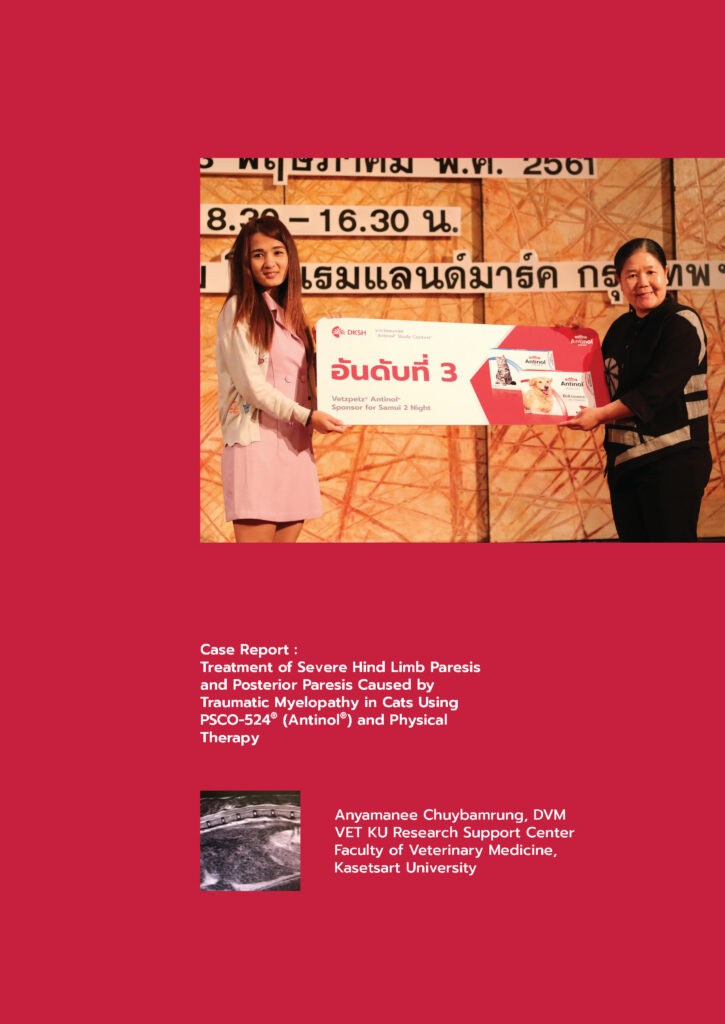
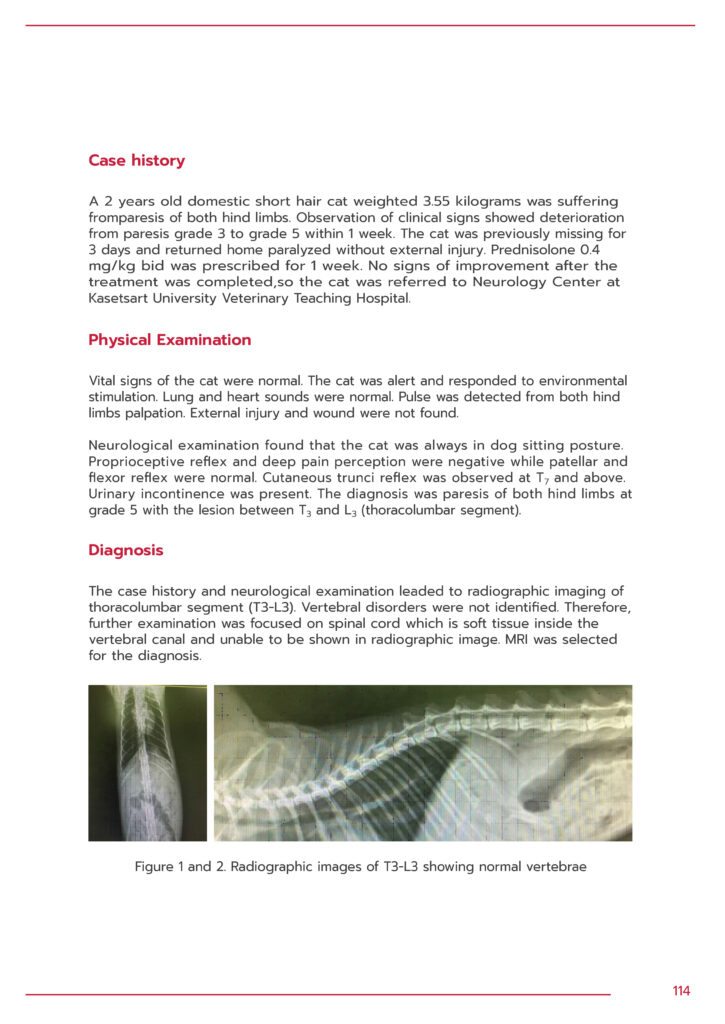
Efficacy of Oral PCSO-524®
as an Anti-Inflammatory Medicationin a Persian Cat with Pruritic Skin Disease

This is a case report of a Persian cat with severe pruritus, which was not improved by topical external parasitic treatment, food trial and 2 months treatment with oral cyclosporine at the dose 5mg/kg. The cat developed corneal ulcer after the long-term treatment with oral cyclosporine.
PCSO-524® (Antinol® Vetz Petz, New Zealand) was replaced cyclosporine as an anti-inflammation treatment and also was considered as a skin barrier support.
The cause of pruritic in this case report was still inconclusive, but the skin lesions of this cat resolved after 2 months supplement with oral PCSO-524® and external parasitic treatment with oral f vluralaner (Bravecto®, MSD).
In conclusion, oral PCSO-524® (Antinol®, Vetz Petz), could be considered as an anti-inflammation and skin barrier support when the cats could not be treated with potent anti-inflammatory medications such as corticosteroid or cyclosporine. The underlying causes of pruritic skin lesions should be corrected in order to manage feline pruritic skin diseases.




Efficacy of PCSO-524® and prednisolone combination treatment for neck pain in Chihuahua dog with Chiari-like malformation and syringomyelia

A 18-month-old male intact chihuahua presented with recurrent neck pain within 3 months after stop using prednisolone.
Upon physical and neurological examination, dog displayed pain and neck stiffness without neurological deficits. Radiographic findings of cervical spine was normal.
The dog was treated with prednisolone to relieve pain and inflammation and showed improvement of clinical signs. However, the recurrence occurred in 7 months with more severity. Magnetic resonance
imaging (MRI) demonstrated Chiari-like malformation and syringomyelia at C2-C4 and C7-T1 region.
PCSO-524® (VetzPetz Antinol®) was administered in combination with prednisolone and gabapentin. The clinical signs improved in 2 weeks so prednisolone was gradually reduced until discontinued but dose of PCSO-524® remained constantly. The dog was able to recover from neck pain and continued life activities as normal.
Long-term supplement of PCSO-524® (VetzPetz Antinol®) was effective for reducing inflammation of spinal cord in dog suffered from neck pain caused by syringomyelia.


The Trial Treatment of Feline Osteoarthritis in an Eleven-Year-Old Cat

A domestic short hair cat aged 11 years was taken to the hospital due to shaking and weakened hind legs. The cat could not perform high jump for 1 month.
Preliminary diagnosis included early stage of osteoarthritis of left hip and capsulitis.
Pain killers, NSAIDs and gabapentin, were administered but the response was not satisfied. Therefore, multimodal treatment program was initiated. Physical therapy using electrical stimulation and laser beam class 4 in conjunction with PCSO-524® were used. Measurement of joint movement angle (active range of motion; active ROM) in 2 dimensions using Kinovea program was conducted for follow up.
The study found increased active ROM and decreased lameness score after the treatment.
The owner described that the cat showed less isolation behavior and was able to perform vertical jump again. Overall quality of the cat’s life was improved.
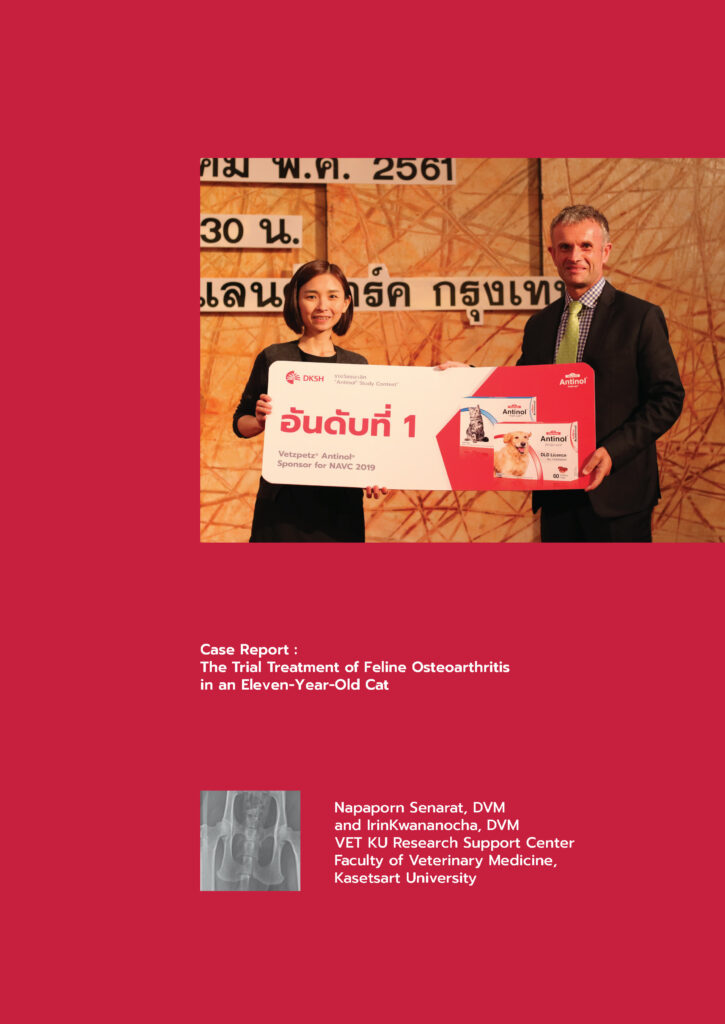

The Treatment of Medial Coronoid Disease in a Seven Months Old Labrador Retriever

Labrador retriever dog aged 7 months with history of right forelimb pain for 1 month was diagnosed as Medial Coronoid Disease (MCD) on both sides.
Radiographic and Computed Tomography (CT) examinations found subtrochlear sclerosis on left elbow. Arthrotomy was operated on the dog using subtotal coronoid ostectomy technique on the medial side of both elbows. Long-term treatment included physical rehabilitation, and nutrition therapy including administration of PCSO-524® and glucosamine/chondroitin sulfate. The dog was followed-up for 6 months for orthopedic examination and assessment by force plate gait analysis.
Two months after the operation, right forelimb could bear body weight, however left forelimb was still lame with lameness score of 1/4. Comparison of radiographic image showed that the left and right elbow was affected from moderate and mild osteoarthritis, respectively. Treatment success for MCD depends on early and accurate detection of the disease and appropriate treatment plan.
Multimodal plan consisting of surgical treatment, medication, nutrition therapy and physical rehabilitation, is proposed.
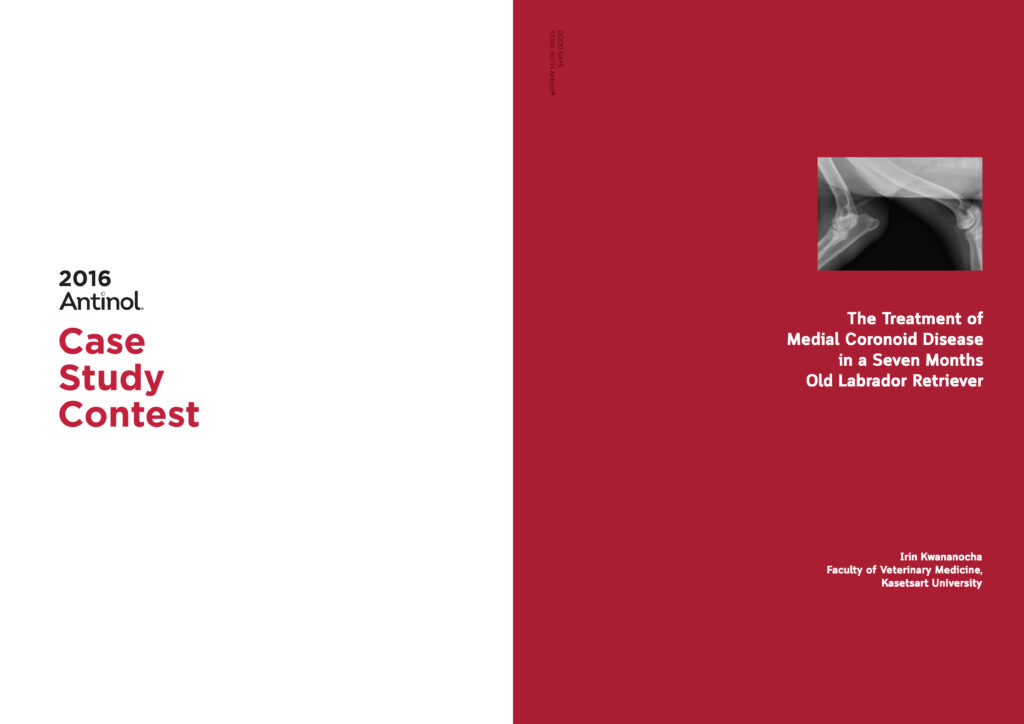

Use of PCSO-524® in Combination with Prednisolone for Treatment of Spinal Cord Injury from Disc Protrusion in Dogs

Male Shih tzu dog aged 9 years and 1 month was diagnosed with limb paralysis after jumping 4 days prior to the hospital visit.
The dog showed weak response of forelimb reflex and severe neck pain. X-ray examination showed block vertebrae at C3 and C4.
Magnetic resonance imaging (MRI) examination found mild disc protrusion, compression on spinal cord and myelopathy at C4 and C5 with compression on the right dorsal lamina.
Prednisolone and gabapentin were prescribed to reduce inflammation and pain, respectively.
Follow-up after reduction of prednisolone showed that the dog fell more often while walking and slight neck pain was present. Prednisolone dosage was then increased and PCSO-524® was prescribed to reduce inflammation of the spinal cord. Later examination found that the dog could walk without falling, both forelimbs showed normal reflex, and signs of neck pain disappeared. Termination of prednisolone was then started without any recurrent clinical signs.
After continuous treatment with PCSO-524® for 6 weeks, the dog could walk normally, both forelimbs showed normal reflex, and the ALK level was nearly back to the level prior to the treatment.
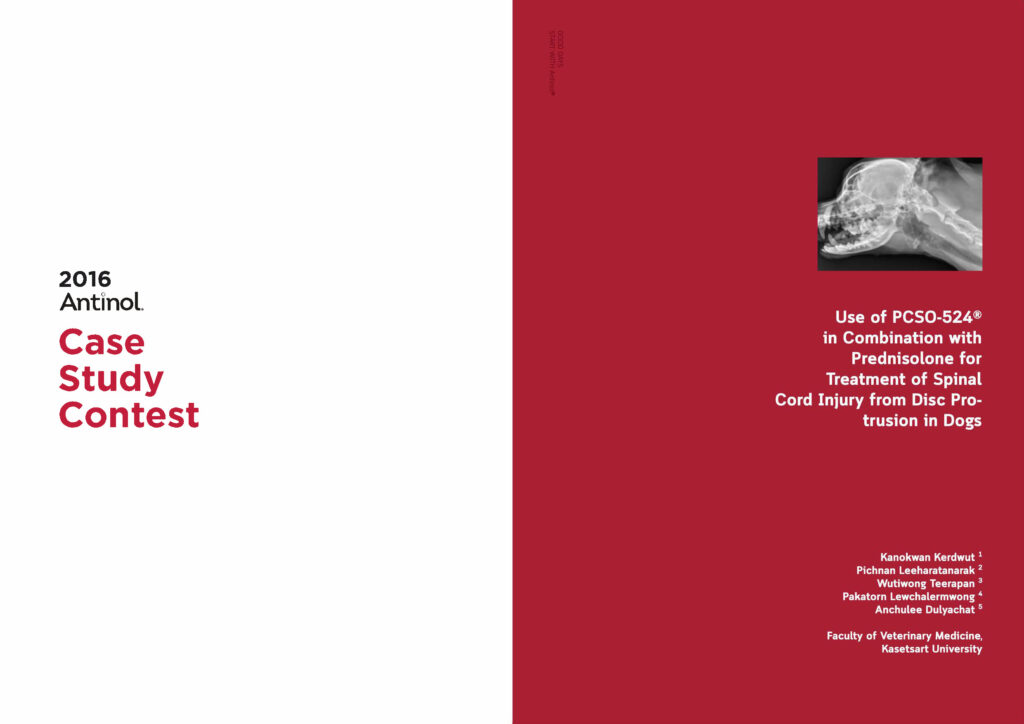
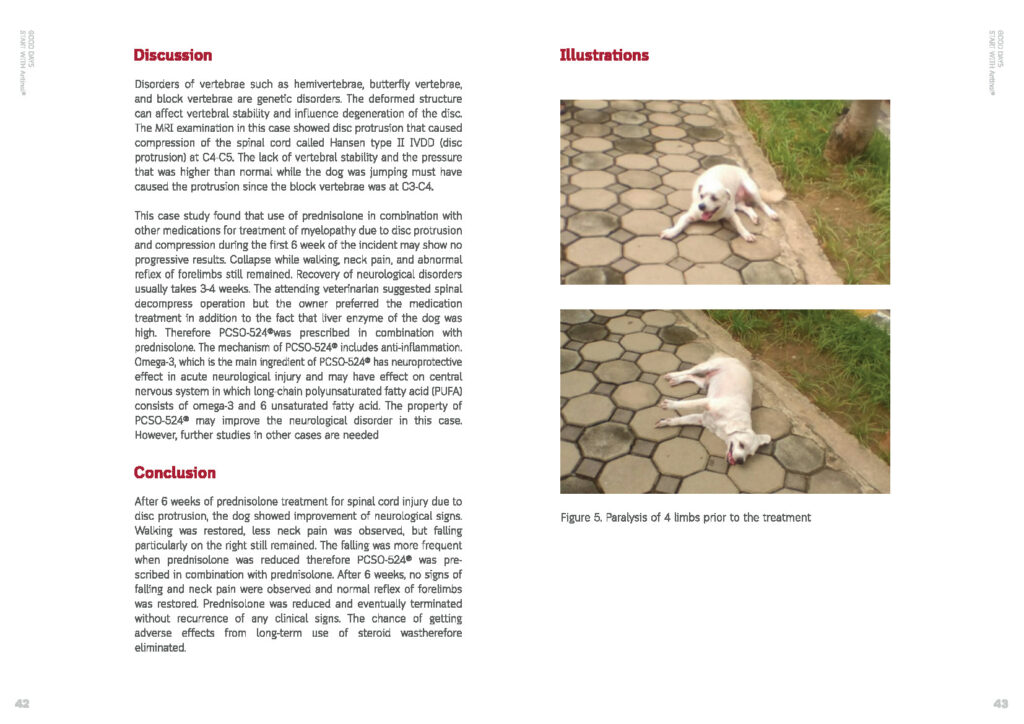
Effectiveness of Disease Modifying Osteoarthritis Agents and Carprofen for Treatment of Canine Osteoarthritis

A prospective, randomized, single-blinded study was conducted to evaluate and compare the effectiveness of disease modifying osteoarthritis agents (DMOAAs) and carprofen by using force plate gait analysis and orthopaedic assessment score (OAS) in osteoarthritic dogs.
Forty dogs with hip and/or stifle osteoarthritis (OA) were assigned randomly into four treatment groups:
PCSO-524, treated with a marine-based fatty-acid compound; GC-ASU, treated with a combination of glucosamine-chondroitin sulphate and avocado/soybean unsaponifiables; CPF, treated with carprofen; and CPF-PCSO, treated with a combination of carprofen and PCSO-524. Each group received the therapeutic agent orally for four weeks.
Peak vertical force (PVF), OAS, haematology and blood chemistry values were evaluated before treatment, and on the second and fourth weeks post-treatment.
No significant effect was found in the PVF, OAS and blood values among the four treatment groups.


The Effectiveness of Marine Based Fatty Acid Compound and NSAIDs for the Treatment of Canine Osteoarthritis: a preliminary study

The Objectives of this study were to investigate the effectiveness of PCSO-524, NSAIDs and combination of NSAIDs and PCSO-524 in the treatment of canine osteoarthritis through the use of force plate gait analysis.
Study Design: A prospective block-randomized single-blinded study.
Animals: Thirty client-owned dogs that had clinical and radiographic evidences of hip or stifle osteoarthritis.

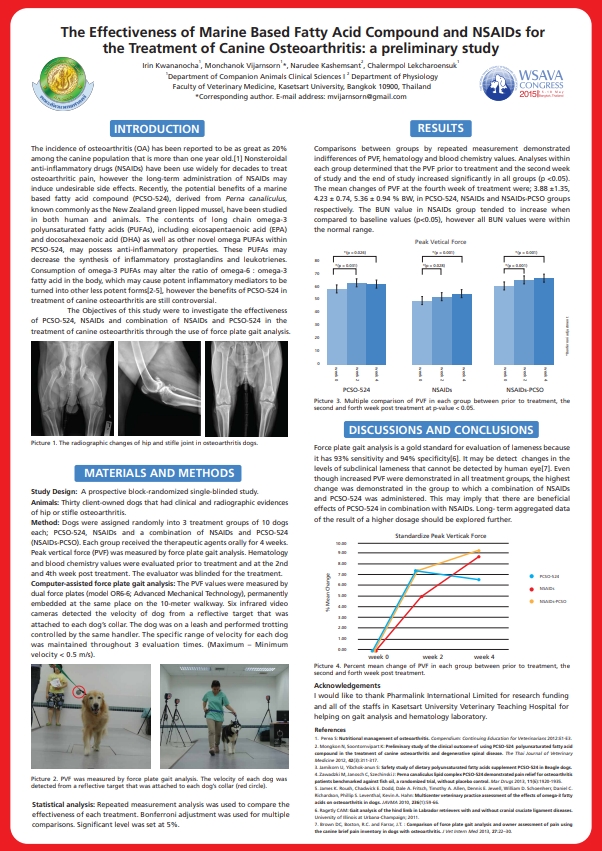

Antinol® Case Study Contest 2016

The 10 Case Studies from Antinol® Case Study Contest of 2016.
1st Winning Awards
1) Effects of PCSO-524® on Inflammation Control in Cats with Chronic Renal Disease after Keratectomy and Conjunctival Pedicle Graft for Treatment of Corneal Sequestrum from Indolent Ulcer
2) The Use of Cyclosporine and PCSO-524® in the Treatment of Alopecia and Dermatitis due to Sebaceous Adenitis in Rabbits
2nd Winning Awards
3) Use of PCSO-524® in Combination with Prednisolone for Treatment of Spinal Cord Injury from Disc Protrusion in Dogs
4) Effects of PCSO-524® on Treatment of Cranial Cruciate Ligament Rupture in Dogs after Tibial Plateau Leveling Osteotomy (TPLO) and Physical Rehabilitation
5) The Treatment of Medial Coronoid Disease in a Seven Months Old Labrador Retriever
3rd Winning Awards
6) A Study of Efficacy and Safety of PCSO-524® (Antinol®l in Treatment of Medial Patellar Luxation and Cranial Cruciate Ligament Rupture in a Yorkshire Terrier Dog
7) Effects of PCSO-524® (Antinol®l Supplementation during 12 Months Follow-up in 2 Cats with Cystitis and Chronic Renal Disease
8) Use of PCSO-524® (Antinol®) for Treatment of Nervous Disorder Caused by Car Accident and Hip Osteoarthritis in Geriatric Cats
9) PCSO-524® as Supportive Therapy for Generalized Alopcia in Guinea Pigs
10) Use of Acupuncture in Combination with PCS0-524® (Antinol®l for Treatment of Hindlimb Paresis in Prairie Dogs



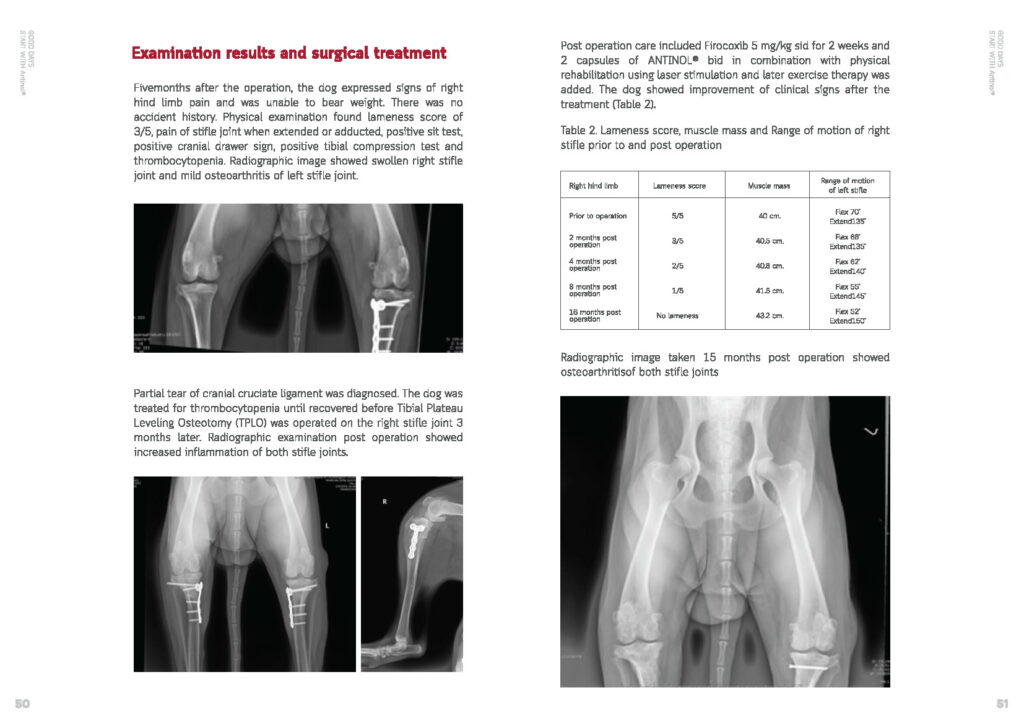
Updated Study Topics
New researches and publications related to PCSO-524® and its result in clnical test submitted by veterinarians on the global conferences every year and the data keeps growing with more studies conducted


 Authors:
Authors: